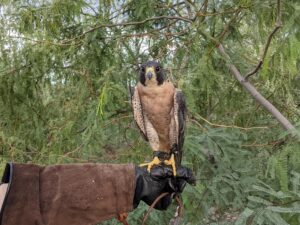Peregrine Falcon – Eurus
 Name: Eurus – Male
Name: Eurus – Male
Species: Peregrine Falcon
Liberty Arrival: Spring, 2018/Juvenile
Injury/Condition: Left wing injury
Eurus arrived at Liberty with a left-wing injury just below the wrist. Surgery was not an option because of the location of the injury. Once the injury healed, it was determined that he had limited motion with that wing. His limited flight abilities classified him as non-releasable.
Peregrine Falcon Facts
Description: The peregrine falcon has one of the most global distributions of any bird of prey. This falcon is found on every continent except Antarctica.
Life span: Though most peregrine falcons do not live to be 1 year old (survival rate for the first year is 40%), the average age of those that live beyond the first year is 13. In the wild, the Peregrine Falcon lives from 7 to 15 years. Maximum longevity records for banded birds range from 16 to 20 years.
Prey: The peregrine falcon captures its prey in the air since its primary food consists of birds such as starlings, mourning doves, pigeons, pheasants, and waterfowl.
Babies/Nests: Falcons do not build nests, but rather dig small depressions called “scrapes” in sand, dirt, or debris or in high cliffs, trees, or tall buildings. Sometimes they will use an abandoned hawk’s or raven’s nest. The female will lay between 2 and 6 eggs and the eggs will hatch in 33 to 35 days. The young fledge in 35 to 42 days.
Halcón Peregrino – Eurus
Nombre: Eurus – Macho
Especie: Halcón Peregrino
Llegada a Liberty: Primavera, 2018/Joven
Herida/Condición: Herida a su ala izquierda
Eurus llego a Liberty con una herida a su ala izquierda justo debajo de su muñeca. Cirugía no era una opción por la localización de la herida. Una vez que la herida se curo se determino que tenia movilidad limitada con esa ala. Su movilidad limitada lo clasifico como no poder ser liberado al estado salvaje.
Datos del Halcón Peregrino
Descripción: El halcón peregrino tiene una de las distribuciones mas amplias de cualquier ave de rapiña. Este halcón se encuentra en todos los continentes excepto Antártica.
Duración de vida: Aunque la mayoría de los halcones peregrinos no alcanzan a vivir un año (su tasa de supervivencia de un año es 40%); el promedio de esos que si sobreviven su primer año es 13 años. En el estado salvaje, el halcón peregrino vive de 7 a 15 años. Datos han enseñado que pueden vivir 16 a 20 años.
Presa: El halcón peregrino captura su presa en el aire como comida principalmente consiste en pájaros como estorninos, huilotas, palomas, faisánes, y aves acuáticas.
Nidos: Los halcones peregrinos no construyen nidos, si no excavan hoyos pequeños en la arena o tierra, o en acantilados altos arboles, o edificios altos. Algunas veces usan nidos abandonados de halcones o cuervos.
Crías: La hembra pone 2 a 6 huevos y salen de su cascaron en 33 a 35 días. Los jóvenes se van en 35 a 42 días.


